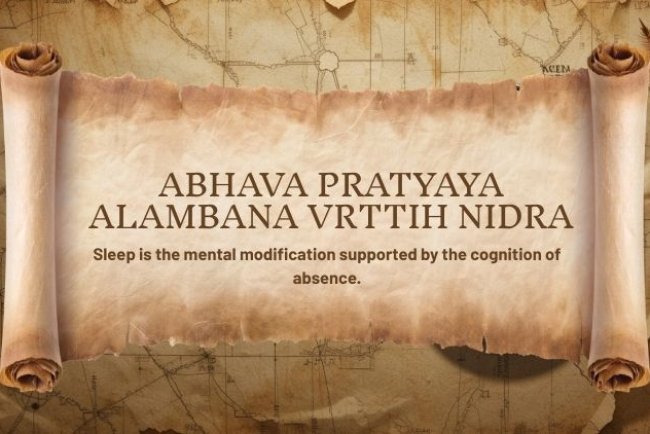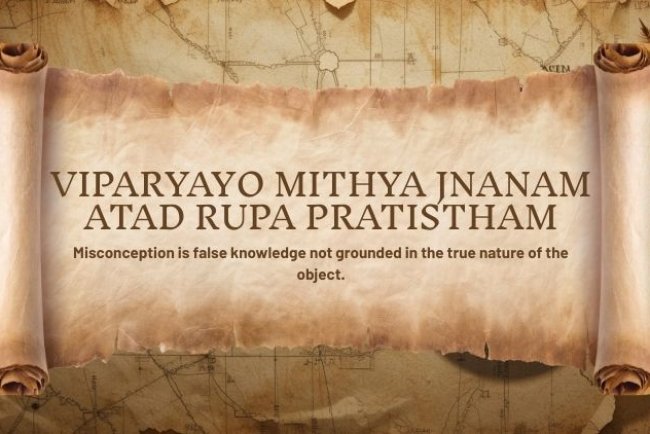Tatparam Purusa Khyateh Guna Vaitrsnyam

When the Self (Purusa) is directly realized, even the subtlest forces of nature (gunas) lose their pull; a higher form of detachment arises.
Every aphorism in Patanjali’s Yoga Sūtras builds on the one before it. In Sutra 1.15, Patanjali defines vairagya—dispassion—as freedom from craving for pleasures we’ve seen or heard about in the world or in scripture. But he doesn’t stop there. In the very next line, Sutra 1.16, he introduces para-vairagya, the higher detachment.
With “tat param purusa-khyateh guna-vaitrsnyam,” we move beyond merely “letting go.” This is the stage where the yogi rests in the direct recognition of the Purusa (the witnessing Self) and is no longer compelled by the gunas—sattva, rajas, and tamas. It isn’t just a concept you read about; it’s a lived clarity that ripens through steady, consistent practice.
In this article, we’ll unpack the sutra’s meaning, how it deepens the idea of detachment from 1.15, practical ways to cultivate this higher freedom, and what it looks like in everyday life.
What does Sutra 1.16 mean?
In Sutra 1.15, Patanjali defines vairagya as the absence of craving for material or worldly things—whether real or imagined.
But in Sutra 1.16, he takes the idea even deeper. He explains that there is a state of greater dispassion, one that goes beyond freedom from external desires. This higher detachment liberates us from the most subtle conditioning of all—the pull of the gunas (sattva, rajas, and tamas), the fundamental qualities of nature itself.
Here, Patanjali is pointing us toward a freedom that is not just about letting go of possessions or pleasures, but about transcending the very forces that bind the mind and keep us cycling through experience.
Yoga Sutra 1.16 Translation
Sanskrit: तत्परं पुरुषख्यातेर्गुणवैतृष्ण्यम् ॥१६॥
Transliteration: Tatparam purusa khyaateḥ guṇa vaitṛṣṇyam (1.16)
Translation: Supreme detachment arises from direct realization of the Self (Puruṣa) and freedom from the pull of the guṇas.
Word-by-Word Meaning
-
tat — that, referring to the state beyond the earlier definition of detachment
-
param — supreme, ultimate, higher
-
purusa — the Self, pure consciousness, the inner seer
-
khyateh — through realization or direct knowledge
-
guna — the three fundamental qualities of nature: sattva (clarity), rajas (activity), and tamas (inertia)
-
vaitrsnyam — absence of craving, complete freedom from attraction
The Step Beyond Ordinary Detachment
Most spiritual seekers begin their journey by practicing the art of letting go—releasing attachments to materialistic desires such as fame, wealth, possessions, or pleasures. As noted in Sutra 1.15, this process is not easy, but with perseverance one gradually sees the fleeting nature of these pursuits and becomes free from their grip.
Yet, in Sutra 1.16, Patanjali draws our attention to a subtler form of bondage: our deep entanglement with the gunas—the fundamental qualities of nature itself. Sattva brings clarity, harmony, and light; rajas fuels action, passion, and restlessness; while tamas pulls us into inertia, heaviness, and ignorance.
Even though sattva may appear desirable, attachment to any of the guṇas still keeps us bound. True freedom arises only when the yogi directly experiences the Purusa (the Self). At this stage, the pull of the guṇas falls away, and what remains is pure, limitless consciousness—unconditioned, unbounded, and free.
Why is this Supreme Detachment Important?
At first, the idea of separating from the gunas may seem abstract. After all, isn’t the goal of yoga to cultivate sattva—clarity, harmony, and balance? And yes, nurturing sattva is an essential and practical step on the path.
But Patañjali reminds us that yoga is not about exchanging one form of bondage for another. Each guṇa, if clung to, becomes a chain:
-
Holding onto tamas leads to stagnation, ignorance, and inertia.
-
Holding onto rajas traps us in endless cycles of action, restlessness, and desire.
-
Even holding onto sattva keeps us bound—though serene, it is still a subtle attachment.
Supreme detachment (para-vairagya) matters because it frees us not only from the obvious distractions of life, but also from the deepest, most refined bonds of nature itself. What remains is unshakable freedom—resting in the pure awareness of the Self.
How Does One Cultivate Para-Vairāgya?
It takes more than willpower to achieve this ultimate level of detachment. It naturally evolves when the yogi possesses:
-
Steady Abhyasa (Practice): Continuous and sincere effort in terms of concentration, meditation, and self-awareness builds a strong foundation.
-
Ordinary Vairagya (from Sutra 1.15): Releasing desires for material objects is the first step. This prepares the mind for deeper freedom.
-
Self-clarity, or Purusa-khyati: The yogi immediately observes the Self through insight, discernment (viveka), and meditation. Attachment to the guṇas easily disappears after this realization.
To put it simply, para-vairāgya cannot be enforced. It emerges as the fine outcome of inner wisdom. Just as darkness disappears when the sun rises, so too does everything else naturally fade away when the Self is visible.
The Difference Between Sutra 1.15 and Sutra 1.16
-
Sutra 1.15 — Vairagya: Freedom from desire for things of the world, whether experienced directly or described in the scriptures. This includes letting go of possessions, achievements, and sensory pleasures.
-
Sutra 1.16 — Para-Vairagya: Through direct realization of the Self, even the pull of the guṇas is transcended. This is not just detachment—it is complete liberation.
Think of it like climbing a mountain:
At first, you drop the heavy stones you’ve been carrying (Sutra 1.15). But at the summit, something greater happens—the mountain itself dissolves into the vast, boundless sky (Sutra 1.16).
Practical Reflections for Daily Life
Although para-vairagya may sound lofty, its wisdom is deeply practical and accessible in everyday living:
-
Less reliance on circumstances: Inner peace is no longer dictated by changing events or outcomes.
-
Freedom in relationships: We can love deeply and connect authentically, without clinging or making others responsible for our happiness.
-
Inner stability: Rooted in something beyond success or failure, we remain composed and centered through life’s ups and downs.
-
Authentic living: Instead of being driven by rajas, tamas, or even sattva, our choices flow from pure awareness and conscious intent.
In this way, supreme detachment doesn’t distance us from life—it allows us to live it with greater clarity, freedom, and compassion.
Para-Vairagya and Meditation
During meditation, we often touch moments of bliss, lightness, or joy. The mind is quick to label these as signs of “success” and wants to hold onto them. Yet, Patanjali reminds us that even attachment to these sattvic states is still a form of bondage.
The true aim is not to collect experiences but to rest in the awareness that perceives them. The yogi learns to simply observe thoughts, emotions, and sensations—without grasping, without labeling. Over time, even the attraction of blissful states or subtle visions fades away. What remains is pure, boundless consciousness—the Self itself.
Conclusion
Yoga Sutra 1.16 marks a profound turning point in Patanjali’s teachings. It reminds us that yoga is not merely about calming the mind or giving up desires—it is about awakening to such clarity of Self that even the most subtle attractions of nature lose their grip.
Para-vairagya—supreme detachment—is the state where the yogi abides in pure awareness, free from all attributes and limitations. This is not a distant ideal but a living possibility, available to every sincere seeker who walks the path with patience, practice, and devotion.
What's Your Reaction?


























